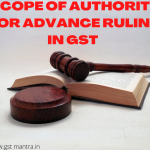
RATE OF GST LEVIABLE ON TYRES AND TUBES MEANT FOR E-RICKSHAW – by Adv. Nidhi Gupta
Goods and Service Tax is a tax levied on the supply of goods and services. Once the liability of payment of goods and service tax is established, the next question arises that what is the amount of duty payable. The two step process is (a) Correctly classify the goods/services, to find out rate of tax applicable (b) Find its assessable value to which the rate of duty is to be applied for calculating amount of duty payable.
The rate of tax is found out by classifying the product in its appropriate heading under the Tax Notifications issued by the government in lieu of the charging section under the GST Act.
Many a times it is found that a product may be classified under more than one heading in said notifications and the problem arises when the rate of tax is different in those headings.
Recently, a new controversy has come up wherein a lot of manufacturers are clearing Tyres and Tubes of E-Rickshaw, by charging 5 percent GST and have started to receive Show Cause Notice to pay GST at 28 percent. The prescribed GST rate for Tyres of bicycles, cycle-rickshaws and three wheeled powered cycle rickshaws; and Rear Tractor tyres is 5% and for other Tyres is 28%.
The question at hand is, whether E-Rickshaw is covered under the phrase “three wheeled powered cycle rickshaws” or not, the tyres/tubes of which are liable to be taxed at 5%. The S Notice issued in this regard by the authorities is relying on the definition of powered cycle rickshaw as per SSI exemption notification no. 8/2003-Central Excise dated 1st March, 2003 and Notification number 102/76 dated 16-3-1976 , to show that E-rickshaw and Cycle-ricks Powered cycle rickshaw are two distinct commodities and therefore E-Rickshaw Tyres and Tubes attract GST as tabulated supra. The definition so relied upon by the Department is reproduced hereunder for ready reference:
“Powered Cycle or Powered Cycle Rickshaw means a mechanically propelled cycle or as the case may be mechanically propelled cycle rickshaw, which may also be paddled, If any necessity arises for so doing.”
Now, the question is whether the said definition as contained in Notifications under Central Excise Law have any application for determining the GST Rate. GST Law is a complete code in itself and contain no provision to apply definitions given under repealed Central Excise Act, or Notifications issued thereunder. It is a settled law that when a term is not defined in a particular Statute then its popular and common meaning have to be preferred over its definition given under any other Statute, as held by Hon’ble High Court of Madhya Pradesh in Commissioner of Sales Tax Vs. M. P. Agro pesticides Ltd. MANU/MP/0270/1995.
In common usage, rickshaw is generally understood as two or three wheeled passenger cart pulled by one man and a powered cycle rickshaw could be powered mechanically or electrically since there is no qualification added to the word powered in the said Taxing Entry.
Since the primary objective of the Goods and Service Tax is to raise revenue, resort should not be had, for purpose of classification, to the scientific and technical meaning of the terms and expressions used therein, but to their popular meaning, that is to say, the meaning attached to that by those using the product. The burden of proof that a product is classifiable under a particular tariff head is on the revenue and must be discharged by proving that it is so understood by the consumers of product in common parlance as held in CCE v Vicco Laboratories 2005 (179) ELT 17 (SC 3 member bench).
Basic principle of classification, devised more than a century ago by Justice Pollok in Grenfell v IRC, (1876) 1 Ex D 242, continues. As per this principle, a word in the statute should be construed in its popular sense and not in the strict and technical sense. ‘Popular sense’ means that which people conversant with the subject matter with which the statute is dealing, would attribute to it. Legislature does not suppose our merchants to be neutralists, geologists or botanists. This has been confirmed by Supreme Court in various cases like Indo International Industries v. CST, (1981) 3 SCR 294.
Principle applies to words in tariff also- Headings and sub-headings in Central Excise Tariff should be understood not in strict technical sense but in their popular sense, i.e., the meaning assigned to them by those trading and using the product, as held by Hon’ble Supreme Court in Kedia Agglomerated Marbles v. CCE; 2003 AIR SCW 419. Similarly, the rate notifications issued by the government under the new regime of GST also must be interpreted by assigning them meaning in their popular sense.
A classic example on the concept of common parlance is the decision of the Exchequer Court of Canada in The King v. Planter Nut and Chocolate Co. Ltd, (1951) C.L.R. (Ex. Court) 122,. The question involved in the said decision was whether salted peanuts and cashew nuts could be considered to be “fruit” or “vegetable” within the meaning of the Excise Tax Act. Cameron J., delivering the judgment, posed the question as follows:
…would a householder when asked to bring home fruit or vegetables for the evening meal bring home salted peanuts, cashew or nuts of any sort? The answer is obviously ‘no’.
Applying the test, the Court held that the words “fruit” and “vegetable” are not defined in the Act or any of the Acts in pari materia. They are ordinary words in every-day use and are therefore, to be construed according to their popular sense.
Hence, according to the author, e-rickshaw is very well covered within the scope of the phrase “three wheeled powered cycle rickshaws” going by the terms used in common trade paralance:
- E-rickshaw is three wheeled
- E-rickshaw is powered (electrically)
- E-rickshaw is a cycle rickshaw, as it is a passenger cart,
For the argument sake also, if the phrase “three wheeled powered cycle rickshaws” can have two interpretations, one including the e-rickshaw thus giving benefit to the assessee and other not including the e-rickshaw thus taking away the benefit from the assesse, the former interpretation must be followed. In case of doubt or ambiguity, construction in favour of assessee to be adopted. In CIT v Shahzadanand, AIR 1966 SC 1342, it was observed that if there be any doubt or if there be two alternative interpretations possible, taxing statute must be interpreted in favour of the assessee and against the revenue authority.
Lastly, as per the declared policy of Government, the 28% peak rate is applicable only to demerit or luxury goods. E-rickshaw as well as Auto-rickshaw are public transport vehicle of lower section of society and cannot be termed neither as ‘demerit goods’ nor as ‘Luxury item’. Moreover, the GST rate of Electrically operated Three Wheeled Vehicle is only 12%, whereas GST rate on other passenger transport vehicle is 28%. Similarly, Compensation Cess @ 15% is prescribed on Passenger Transport Vehicles, but again there is no compensation Cess on Three Wheeled Vehicles. Thus, the Govt. itself is not considering such vehicles as Luxury or demerit goods, and hence parts and components of such vehicles can also not be taxed @ 28%.
Therefore, according to the author, Pneumatic tyres or inner tubes, of rubber, of a kind used in e-rickshaw and even auto-rickshaw attract only 5% GST.




Leave A Comment